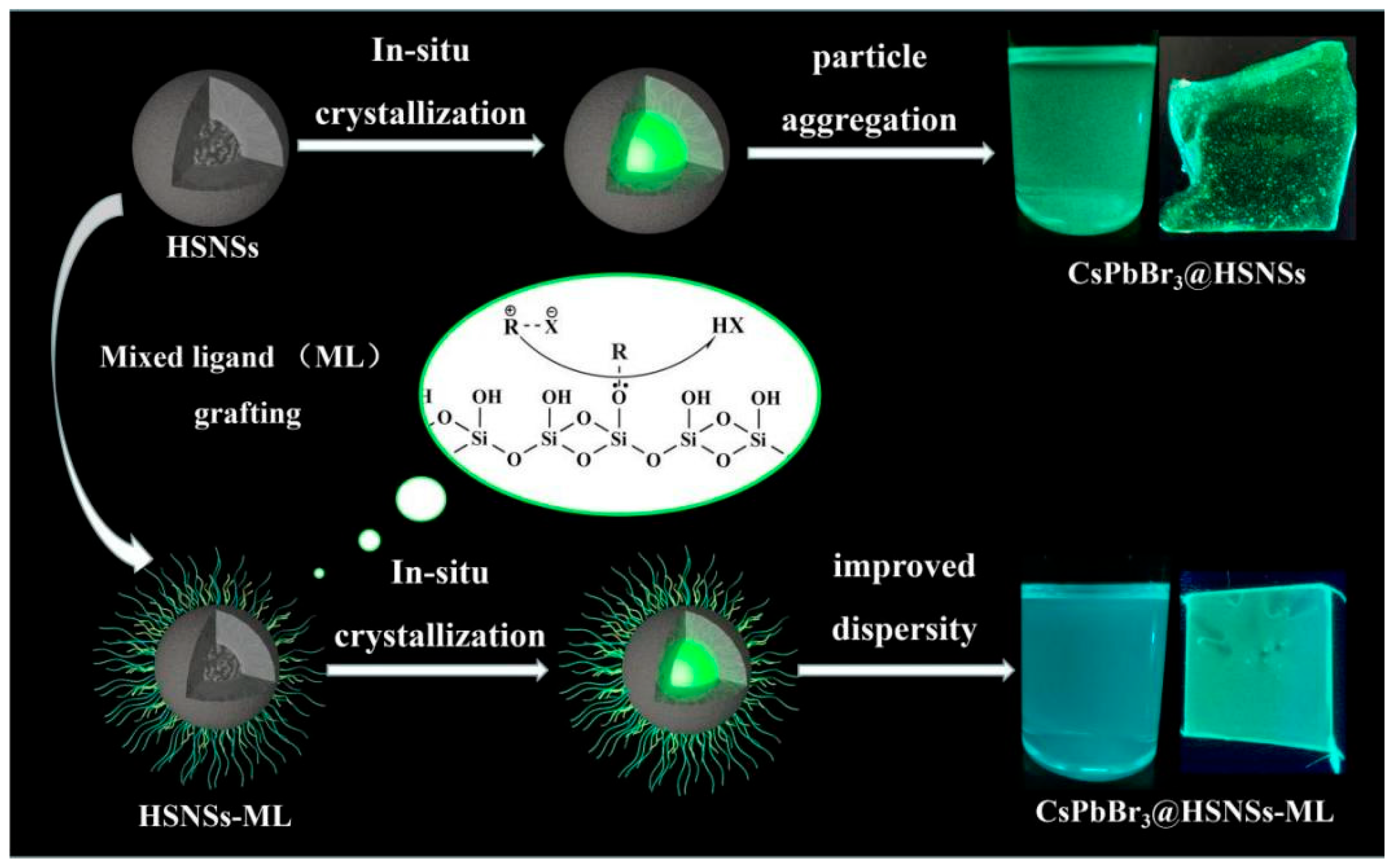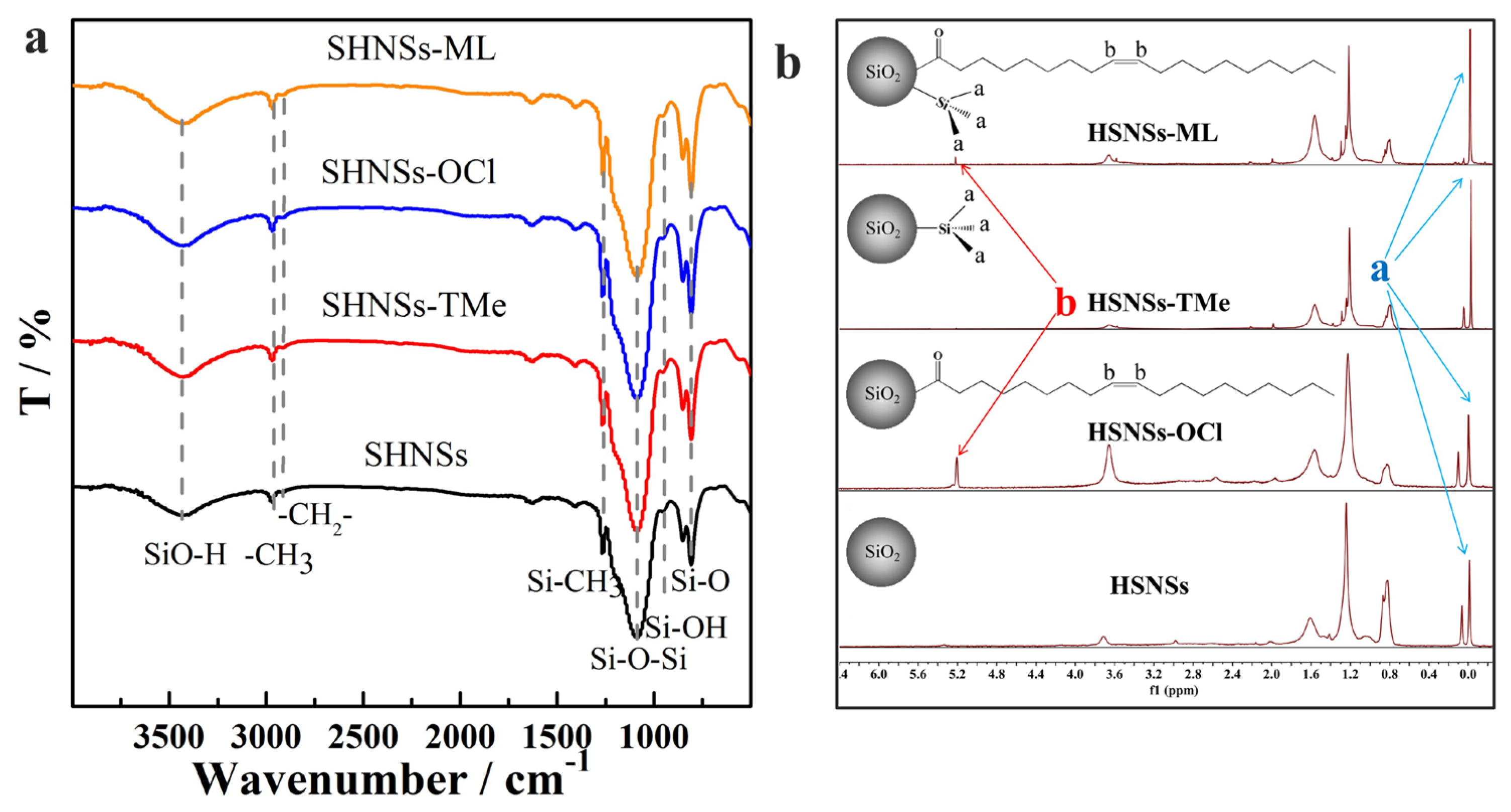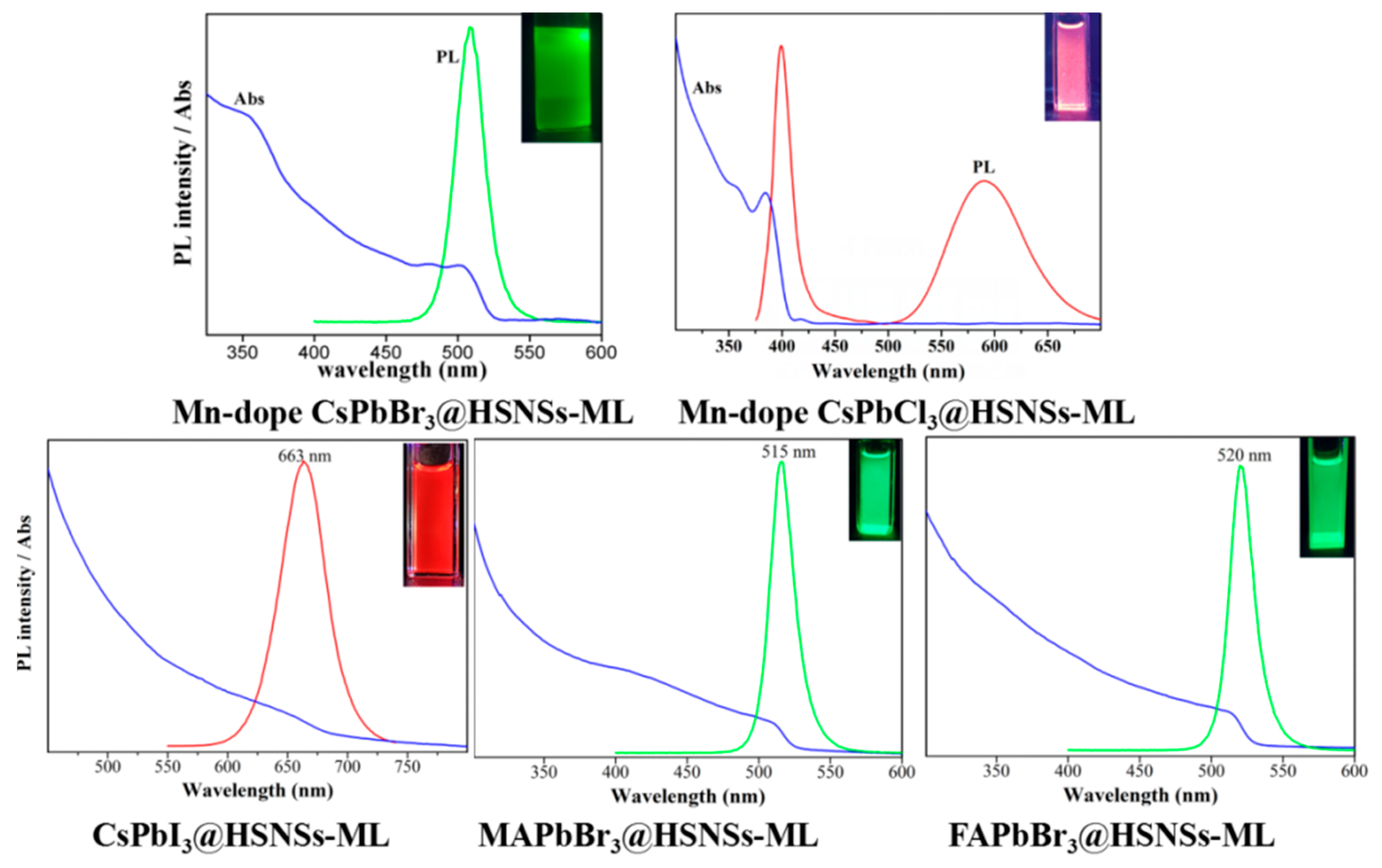Improving Stability and Colloidal Dispersity of CsPbBr3@SiO2 Nanoparticles Based on In-Situ Synthesis in Entropy Ligands Functionalized SiO2 Nanoreactor
Abstract
:1. Introduction
2. Materials and Methods
2.1. Materials
2.2. Experimental Section
2.3. Sample Characterization
3. Results and Discussion
4. Conclusions
Author Contributions
Funding
Acknowledgments
Conflicts of Interest
References
- Protesescu, L.; Yakunin, S.; Bodnarchuk, M.I.; Krieg, F.; Caputo, R.; Hendon, C.H.; Yang, R.X.; Walsh, A.; Kovalenko, M.V. Nanocrystals of cesium lead halide perovskites (CsPbX3, X = Cl, Br, and I): Novel optoelectronic materials showing bright emission with wide color gamut. Nano Lett. 2015, 15, 3692–3696. [Google Scholar] [CrossRef] [Green Version]
- Jeon, N.J.; Na, H.; Jung, E.H.; Yang, T.Y.; Lee, Y.G.; Kim, G.; Shin, H.W.; Seok, S.I.; Lee, J.; Seo, J. A fluorene-terminated hole transporting material for highly efficient and stable perovskite solar cells. Nat. Energy 2018, 3, 682–689. [Google Scholar] [CrossRef]
- Zhou, Q.; Bai, Z.; Lu, W.G.; Wang, Y.; Zou, B.; Zhong, H. In situ fabrication of halide perovskite nanocrystal-embedded polymer composite films with enhanced photoluminescence for display backlights. Adv. Mater. 2016, 28, 9163–9168. [Google Scholar] [CrossRef]
- Lai, Q.; Zhu, L.; Pang, Y.; Xu, L.; Chen, J.; Ren, Z.; Luo, J.; Wang, L.; Chen, L.; Han, K.; et al. Piezo-phototronic effect enhanced photodetector based on CH3NH3PbI3 single crystals. ACS Nano 2018, 12, 10501–10508. [Google Scholar] [CrossRef]
- Wang, J.; Da, P.; Zhang, Z.; Luo, S.; Liao, L.; Sun, Z.; Shen, X.; Wu, S.; Zheng, G.; Chen, Z. Lasing from lead halide perovskite semiconductor microcavity system. Nanoscale 2018, 10, 10371–10376. [Google Scholar] [CrossRef] [PubMed]
- Zhang, F.; Zhong, H.Z.; Chen, C.; Wu, X.G.; Hu, X.M.; Huang, H.L.; Han, J.B.; Zou, B.S.; Dong, Y.P. Brightly luminescent and color-tunable colloidal CH3NH3PbX3 (X = Br, I, Cl) quantum dots: Potential alternatives for display technology. ACS Nano 2015, 9, 4533–4542. [Google Scholar] [CrossRef] [PubMed]
- Prashant, K.; Ganesh, N.; Narayan, K.S. Electrospun fibers containing emissive hybrid perovskite quantum dots. ACS Appl. Mater. Interfaces 2019, 11, 24468–24477. [Google Scholar] [CrossRef]
- Geng, C.; Xu, S.; Zhong, H.Z.; Andrey, L.R.; Bi, W.G. Aqueous synthesis of methylammonium lead halide perovskite nanocrystals. Angew. Chem. Int. Ed. 2018, 130, 9798–9802. [Google Scholar] [CrossRef]
- Wang, L.L.; Nicholas, E.W.; Edward, W.M.; John, P.O.; Dugan, H.; Ryan, E.W.; Philippe, G.S.; Gregory, S.E. Scalable ligand-mediated transport synthesis of organic-inorganic hybrid perovskite nanocrystals with resolved electronic structure and ultrafast dynamics. ACS Nano 2017, 11, 2689–2696. [Google Scholar] [CrossRef]
- Dang, Z.Y.; Shamsi, J.; Palazon, F.; Imran, M.; Akkerman, Q.A.; Park, S.; Bertoni, G.; Prato, M.; Brescia, R.; Manna, L. In situ transmission electron microscopy study of electron beam-induced transformations in colloidal cesium lead halide perovskite nanocrystals. ACS Nano 2017, 11, 2124–2132. [Google Scholar] [CrossRef] [Green Version]
- Huang, S.; Li, Z.; Kong, L.; Zhu, N.; Shan, A.; Li, L. Enhancing the stability of CH3NH3PbBr3 quantum dots by embedding in silica spheres derived from tetramethyl orthosilicate in “waterless” toluene. J. Am. Chem. Soc. 2016, 138, 5749–5752. [Google Scholar] [CrossRef]
- Luo, B.; Pu, Y.C.; Lindley, S.A.; Yang, Y.; Lu, L.; Li, Y.; Li, X.; Zhang, J.Z. Organolead halide perovskite nanocrystals: Branched capping ligands control crystal size and stability. Angew. Chem. Int. Ed. 2016, 55, 8864–8868. [Google Scholar] [CrossRef] [Green Version]
- Zhang, H.; Wang, X.; Liao, Q.; Xu, Z.; Li, H.; Zheng, L.; Fu, H. Embedding perovskite nanocrystals into a polymer matrix for tunable luminescence probes in cell imaging. Adv. Funct. Mater. 2017, 27, 1604382. [Google Scholar] [CrossRef]
- Chen, L.; Tan, Y.Y.; Chen, Z.X.; Wang, T.; Hu, S.; Nan, Z.A.; Xie, L.Q.; Hui, Y.; Huang, J.X.; Zhan, C.; et al. Toward long-term stability: Single-crystal alloys of cesium-containing mixed cation and mixed halide perovskite. J. Am. Chem. Soc. 2019, 141, 1665–1671. [Google Scholar] [CrossRef]
- Yang, D.; Cao, M.; Zhong, Q.; Li, P.; Zhang, X.; Zhang, Q. All-inorganic cesium lead halide perovskite nanocrystals: Synthesis, surface engineering and applications. J. Mater. Chem. C 2019, 7, 757–789. [Google Scholar] [CrossRef]
- Yang, D.; Li, X.; Zeng, H. Surface chemistry of all inorganic halide perovskite nanocrystals: Passivation mechanism and stability. Adv. Mater. Interfaces 2018, 5, 1701662. [Google Scholar] [CrossRef] [Green Version]
- Liu, M.N.; Ali-Löytty, H.; Hiltunen, A.; Sarlin, E.; Qudsia, S.; Smått, J.H.; Valden, M.; Vivo, P. Manganese doping promotes the synthesis of bismuth-based perovskite nanocrystals while tuning their band structures. Small 2021, 17, 2100101. [Google Scholar] [CrossRef] [PubMed]
- Liu, M.N.; Pasanen, H.; Ali-Löytty, H.; Hiltunen, A.; Lahtonen, K.; Qudsia, S.; Smått, J.H.; Valden, M.; Tkachenko, N.V.; Vivo, P. B-site co-alloying with germanium improves the efficiency and stability of all-inorganic tin-Based perovskite nanocrystal solar cells. Angew. Chem. Int. Ed. 2020, 132, 22117–22125. [Google Scholar] [CrossRef] [PubMed]
- Hou, S.C.; Guo, Y.Z.; Tang, Y.G.; Quan, Q.M. Synthesis and stabilization of colloidal perovskite nanocrystals by multidentate polymer micelles. ACS Appl. Mater. Interfaces 2017, 9, 18417–18422. [Google Scholar] [CrossRef] [PubMed]
- Huang, Y.J.; Chen, H.C.; Lin, H.-K.; Wei, K.H.; Su, Y.W. Block copolymer-tuned fullerene electron transport layer enhances the efficiency of perovskite photovoltaics. ACS Appl. Mater. Interfaces 2016, 8, 24603–24611. [Google Scholar] [CrossRef]
- Raja, S.N.; Bekenstein, Y.; Koc, M.A.; Fischer, S.; Zhang, D.; Lin, L.; Ritchie, R.O.; Yang, P.; Alivisatos, A.P. Encapsulation of perovskite nanocrystals into macroscale polymer matrices: Enhanced stability and polarization. ACS Appl. Mater. Interfaces 2016, 8, 35523–35533. [Google Scholar] [CrossRef] [PubMed] [Green Version]
- Zhao, H.; Benetti, D.; Tong, X.; Zhang, H.; Zhou, Y.; Liu, G.; Ma, D.; Sun, S.; Wang, Z.M.; Wang, Y.; et al. Efficient and stable tandem luminescent solar concentrators based on carbon dots and perovskite quantum dots. Nano Energy 2018, 50, 756–765. [Google Scholar] [CrossRef]
- Cai, Y.; Wang, L.; Zhou, T.; Zheng, P.; Li, Y.; Xie, R.J. Improved stability of CsPbBr3 perovskite quantum dots achieved by suppressing interligand proton transfer and applying a polystyrene coating. Nanoscale 2018, 10, 21441–21450. [Google Scholar] [CrossRef] [PubMed]
- Wei, Y.; Deng, X.; Xie, Z.; Cai, X.; Liang, S.; Ma, P.; Hou, Z.; Cheng, Z.; Lin, J. Enhancing the stability of perovskite quantum dots by encapsulation in crosslinked polystyrene beads via a swelling-shrinking strategy toward superior water resistance. Adv. Funct. Mater. 2017, 27, 1703535. [Google Scholar] [CrossRef]
- Liang, X.; Chen, M.; Wang, Q.; Guo, S.; Yang, H. Ethanol-precipitable, silica-passivated perovskite nanocrystals incorporated into polystyrene microspheres for long-term storage and reusage. Angew. Chem. Int. Ed. 2019, 131, 2825–2829. [Google Scholar] [CrossRef]
- Ding, R.; Zhang, X.; Chen, G.; Wang, H.; Kishor, R.; Xiao, J.; Gao, F.; Zeng, K.; Chen, X.; Sun, X.W.; et al. High-performance piezoelectric nanogenerators composed of formamidinium lead halide perovskite nanoparticles and poly(vinylidene fluoride). Nano Energy 2017, 37, 126–135. [Google Scholar] [CrossRef]
- Sultana, A.; Sadhukhan, P.; Alam, M.M.; Das, S.; Middya, T.R.; Mandal, D. Organo-lead halide perovskite induced electroactive β-phase in porous PVDF films: An excellent material for photoactive piezoelectric energy harvester and photodetector. ACS Appl. Mater. Interfaces 2018, 10, 4121–4130. [Google Scholar] [CrossRef]
- Ryu, U.; Jee, S.; Park, J.S.; Han, I.K.; Lee, J.H.; Park, M.; Kyung, M.C. Nanocrystalline titanium metal-organic frameworks for highly efficient and flexible perovskite solar cells. ACS Nano 2018, 12, 4968–4975. [Google Scholar] [CrossRef]
- Rambabu, D.; Bhattacharyya, S.; Tarandeep, S.; Chakravarthy, M.L.; Tapas, K.M. Stabilization of MAPbBr3 perovskite quantum dots on perovskite MOFs by a one-step mechanochemical synthesis. Inorg. Chem. 2020, 59, 1436–1443. [Google Scholar] [CrossRef]
- Li, Z.J.; Hofman, E.; Li, J.; Davis, A.H.; Tung, C.H.; Wu, L.Z.; Zheng, W. Photoelectrochemically active and environmentally stable CsPbBr3/TiO2 core/shell nanocrystals. Adv. Funct. Mater. 2018, 28, 1–7. [Google Scholar] [CrossRef]
- Dibyashree, K.; Lotte, H.; Valerio, Z.; Vincent, V.; Marcel, A.V.; Wilhelmus, M.M.K.; Mariadriana, C. Chemical analysis of the interface between hybrid organic-inorganic perovskite and atomic layer deposited Al2O3. ACS Appl. Mater. Interfaces 2019, 11, 5526–5535. [Google Scholar] [CrossRef] [Green Version]
- Yu, H.; Xu, X.; Liu, H.; Wan, Y.; Cheng, X.; Chen, J.; Ye, Y.; Dai, L. Waterproof cesium lead bromide perovskite lasers and their applications in solution. ACS Nano 2020, 14, 552–558. [Google Scholar] [CrossRef] [PubMed]
- Sun, J.Y.; Rabou, F.T.; Yang, X.F.; Huang, X.P. Facile two-step synthesis of all-inorganic perovskite CsPbX3 (X = Cl, Br, and I) zeolite-Y composite phosphors for potential backlight display application. Adv. Funct. Mater. 2017, 27, 1704371. [Google Scholar] [CrossRef]
- Ye, S.; Sun, J.; Han, Y.; Zhou, Y.; Zhang, Q. Confining Mn2+-doped lead halide perovskite in zeolite-Y as ultrastable orange-red phosphor composites for white light-emitting diodes. ACS Appl. Mater. Interfaces 2018, 10, 24656–24664. [Google Scholar] [CrossRef] [PubMed]
- Zhong, Q.; Cao, M.; Hu, H.; Yang, D.; Chen, M.; Li, P.; Wu, L.; Zhang, Q. One-pot synthesis of highly stable CsPbBr3@SiO2 core-shell nanoparticles. ACS Nano 2018, 12, 8579–8587. [Google Scholar] [CrossRef]
- Dirin, D.N.; Protesescu, L.; Trummer, D.; Kochetygov, I.V.; Yakunin, S.; Krumeich, F.; Stadie, N.P.; Kovalenko, M.V. Harnessing defect-tolerance at the nanoscale: Highly luminescent lead halide perovskite nanocrystals in mesoporous silica matrixes. Nano Lett. 2016, 16, 5866–5874. [Google Scholar] [CrossRef] [PubMed]
- He, Y.J.; Yoon, Y.J.; Harn, Y.W.; Gill, V.B.M.; Liang, S.; Lin, C.H.; Tsukruk, V.V.; Thadhani, N.; Kang, Z.T.; Lin, Z.Q. Unconventional route to dual-shelled organolead halide perovskite nanocrystals with controlled dimensions, surface chemistry, and stabilities. Sci. Adv. 2019, 5, eaax4424. [Google Scholar] [CrossRef] [PubMed] [Green Version]
- Pang, F.Z.; Zhang, J.; Cao, W.C.; Kong, X.Q.; Peng, X.G. Partitioning surface ligands on nanocrystals for maximal solubility. Nat. Commun. 2019, 10, 2454. [Google Scholar] [CrossRef] [Green Version]
- Yang, Y.; Qin, H.Y.; Peng, X.G. Intramolecular entropy and size-dependent solution properties of nanocrystal-ligands complexes. Nano Lett. 2016, 16, 2127–2132. [Google Scholar] [CrossRef] [PubMed]
- Huang, Y.P.; Li, F.M.; Qiu, L.H.; Lin, F.Y.; Lai, Z.W.; Wang, S.Y.; Lin, L.H.; Zhu, Y.M.; Wang, Y.; Jiang, Y.Q.; et al. Enhancing the stability of CH3NH3PbBr3 nanoparticles using double hydrophobic shells of SiO2 and poly(vinylidene fluoride). ACS Appl. Mater. Interfaces 2019, 11, 26384–26391. [Google Scholar] [CrossRef]








Publisher’s Note: MDPI stays neutral with regard to jurisdictional claims in published maps and institutional affiliations. |
© 2021 by the authors. Licensee MDPI, Basel, Switzerland. This article is an open access article distributed under the terms and conditions of the Creative Commons Attribution (CC BY) license (https://creativecommons.org/licenses/by/4.0/).
Share and Cite
Chen, T.; Zhang, P.; Chen, G.; Yang, Q.; Li, F. Improving Stability and Colloidal Dispersity of CsPbBr3@SiO2 Nanoparticles Based on In-Situ Synthesis in Entropy Ligands Functionalized SiO2 Nanoreactor. Crystals 2021, 11, 1165. https://doi.org/10.3390/cryst11101165
Chen T, Zhang P, Chen G, Yang Q, Li F. Improving Stability and Colloidal Dispersity of CsPbBr3@SiO2 Nanoparticles Based on In-Situ Synthesis in Entropy Ligands Functionalized SiO2 Nanoreactor. Crystals. 2021; 11(10):1165. https://doi.org/10.3390/cryst11101165
Chicago/Turabian StyleChen, Tianju, Peng Zhang, Guoliang Chen, Qi Yang, and Feiming Li. 2021. "Improving Stability and Colloidal Dispersity of CsPbBr3@SiO2 Nanoparticles Based on In-Situ Synthesis in Entropy Ligands Functionalized SiO2 Nanoreactor" Crystals 11, no. 10: 1165. https://doi.org/10.3390/cryst11101165
APA StyleChen, T., Zhang, P., Chen, G., Yang, Q., & Li, F. (2021). Improving Stability and Colloidal Dispersity of CsPbBr3@SiO2 Nanoparticles Based on In-Situ Synthesis in Entropy Ligands Functionalized SiO2 Nanoreactor. Crystals, 11(10), 1165. https://doi.org/10.3390/cryst11101165





